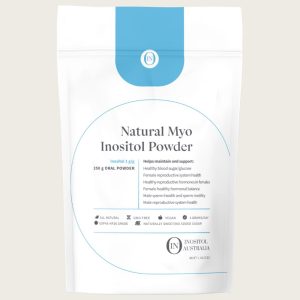
Insulin resistance is a life-changing condition that requires continual management. Luckily there are lifestyle changes and natural treatments that can make living with insulin resistance far easier.
One thing that women with insulin resistance should consider doing is exercising. As we will explain, the “huff and puff” aerobic exercises are the best for reducing insulin sensitivity as they get your heart pumping and help move glucose into your muscles.
While you are considering lifestyle changes, also look at your diet to make sure that it is optimized for your insulin resistance (or PCOS needs if you have that) and consider inositol supplements to support you.
Read on to learn why exercise is so important and to learn about some of the best exercises for women with insulin resistance:
What Does Exercise Do for Women With Insulin Resistance?
Our body naturally converts sugar into glucose using insulin. But when our muscle, fat, and liver cells don’t respond to the insulin, the pancreas produces more and causes insulin resistance systems. These can result in prediabetes, type 2 diabetes, gestational diabetes and metabolic syndrome.
While scientists aren’t certain why insulin resistance happens, they do know that exercise helps with weight loss and facilitates the absorption of glucose into the muscle, fat, and liver cells. It can even go as far as reversing high blood sugar levels or preventing insulin sensitivity from happening to begin with.
Research from the Diabetes Prevention Program found intensive lifestyle intervention led to weight loss and reduced the occurrence of type 2 diabetes in certain demographics over three years. And other studies have found that exercise has a beneficial influence on insulin resistance.
So how does this work? Since our body burns glycogen during exercise, it seeks out glucose more often. It might grab glucose that is stored in your muscles during the activity, but afterwards, the muscles need to replenish their stores. It is believed that muscles take up the glycogen floating around in your blood (the stuff that was previously not taken up by your cells), also known as blood glucose, to replenish muscle stores.
The more glycogen that is burned, then the longer the body’s insulin sensitivity is improved.
So, yes, while we would say here that “more is better,” know that you don’t have to do vigorous exercise all the time for exercise to be effective. Physical activity in general is good for lowering your blood sugar level, high blood pressure, and improving cardiovascular health (among so many other things). So even a little movement can go a long way.
3 Best Types of Exercise for Women With Insulin Resistance
Regular exercise is good for everybody, regardless of any medical conditions one has. The American Heart Association recommends 150 minutes of exercise per week. The type of exercise can range, but the important thing is that your heart rate gets up.
Small changes like going for 15 minute walks every day or going to the gym a few times a week, can improve your metabolism over time as well.
Here are some of the best types of exercises that women should consider for improving their insulin resistance and balancing blood sugar:
Aerobic Exercise
Aerobic exercises are those that are more like heart rate conditioning. Think about walking, swimming, jogging, biking, and the elliptical at the gym. These activities are less focused on building muscle and instead focus on keeping the heart rate elevated for an extended period of time.
Exercises that are great for women with insulin resistance are HIIT workouts, walking, and biking. Try to do these workouts a few times a week (aim for 2 to 3) and for 15 to 30 minutes each time. You can then start to increase your time and add in more workouts and more workout types.
Of course, a lot of exercising is finding the activities that you love the most! Not everyone loves walking, but you might love swimming, skiing, or even skateboarding. Try to find something that you want to do more frequently as the most successful form of exercise is the one that you will actually do!
Strength Training
Certain types of weight training can also help with insulin resistance. Resistance training, which is any training that is focused on building muscle, should contain bursts of movement that may be strenuous to your muscles or force yourself to focus your strength in order to move a heavy weight.
Weight training should be difficult and get your heart pumping, but not because you are moving fast. It’s instead because your body is working hard to lift something heavy.
Because resistance training gets your heart rate up, this makes it an ideal candidate for improving insulin sensitivity.
Stretching and Coordination Movements
With any workout plan, we have to recommend stretching, relaxation, and coordination exercises. These will help to improve your agility, your flexibility, and allow your connective tissues to remain flexible as you move around.
Things like yoga, agility training, rock climbing, and sports can help here. Not only will this also get your blood pumping, but it will also keep your body feeling good and agile, which in the end helps to make sure you are feeling good and that you continue to work out regularly—the ultimate goals!
Example of the Ideal Workout Plan for Women With Insulin Resistance
Working out is a great insulin resistance treatment and will help women with insulin resistance achieve weight loss.
Of course, what your workout plan looks like will entirely depend on your fitness level. If you are just getting back into working out, then these activities might need to be tailored for your fitness level. Alternatively, if you are regularly active and want to do more, then the same applies.
Here’s an example workout plan to get you started:
Week 1
Go for a walk (15 minutes) three times a week.
Do strength training at the gym (once a week) for 1 hour.
Elliptical for 30 minutes.
Week 2
Go for a walk (15 minutes) three times a week.
Do strength training at the gym (once a week) for 1 hour.
Elliptical for 30 minutes twice a week.
Play basketball with friends once this week.
Week 3
Go for a walk (20 minutes) three times a week.
Do strength training at the gym (once a week) for 1 hour.
Try out the StairMaster for 15 minutes twice a week.
Week 4
Go for a walk (20 minutes) three times a week.
Do strength training at the gym (once a week) for 1 hour.
Do some light stretching or take a yoga class once this week.
As you can see, with this workout plan, there is some consistency and moderate variation. You don’t want to do too much, or add in too many changes, as this can be frustrating both for you personally and your body.
Managing Your Insulin Resistance
As you add in exercises, you’ll also be challenging your body metabolically, and this means that you’ll need to account for this in food changes. Adapting your diet while adapting your exercise plan is nearly impossible to do as a beginner. So, take it easy and listen to your body’s needs.
Especially if you are experiencing insulin fluctuations, you might need to take it easy, do an insulin journal, and monitor the changes. Consider checking in on your blood sugar level more often throughout the day. For support, while your body changes, make sure to align your diet. For example, if you are eating more frequently, then you may need to up your insulin dose. Be sure to contact your medical practitioner for guidance.
If you have polycystic ovary syndrome (PCOS), ideally, you want to consider the PCOS diet before you start exercising. You may also want to consider purchasing a supplement that supports improved insulin uptake, like myo-inositol.
Insulin resistance can be challenging to manage, especially if this is a new thing for you. However, with the proper diet, exercise, and supplementation, you can get ahead of it and potentially reverse it.
References
Insulin Resistance Diet: Meal Planning & Exercise Tips
Best Exercise for Beating Insulin Resistance
American Heart Association Recommendations for Physical Activity in Adults and Kids
10 Best Exercises for Type 2 Diabetes: Cycling, Yoga, and More
Insulin Resistance & Prediabetes | NIDDK.
How to Increase Insulin Sensitivity | Insulin Resistance Treatment | DSM
You May Like
-
Sale Product on saleNatural Myo Inositol for Insulin Resistance$ 34.95 – $ 179.95
-
Sale Product on saleNature’s Sunshine Berberine – 90 Capsules
$ 49.95$ 44.95 You save 10% -
Morlife Collagen Protein Water – 400g – Tropical or Berry$ 54.95
-
Morlife Beauty Collagen Antiox – Berry Deluxe 200g$ 49.95
-
Morlife Plantiful Protein Powder – 440g – Chocolate or Vanilla Fudge$ 44.95
-
Morlife Alkalising Greens – Berry Burst 200g$ 44.95
-
Morlife Berry Clean Liva Detox – Berry Elixir 200g$ 44.95
-
Vital Zing Water Drops$ 6.45











